Answers to all your questions on RPA migration & re-platforming
RPA re-platforming and RPA migration is the process of moving and optimizing an organization’s automated processes from one RPA tool to another. For example, moving all your automated processes from Blue Prism into Microsoft Power Automate.
The motivation to switch RPA platforms and migrate entire automation estates varies from organization to organization, however, the reasons driving migrations normally come down to reducing the total cost of ownership, leveraging better capabilities in next-generation automation platforms, enabling a low-code/no-code digital strategy, and realizing scale by reducing the complexity of automation delivery in more intuitive tools.
There are many reasons why a company or RPA program would want to switch RPA providers. They can range from one or a combination of the following:
- Another provider has more features and more capabilities that suit an organization or RPA program’s needs better
- Another provider democratizes automation more by enabling business users to design and deploy bots because the destination platform is easier to use
- Their current provider is too technically complex, forcing companies to rely too much on IT to develop automated processes, delaying automation delivery and preventing scale
- They want to enable a holistic low-code/no-code digital strategy to solve business problems
- Their current RPA platform is delivering underwhelming ROI
- Their organization is using multiple RPA platforms, creating disparate automation practices and driving up costs, so they’re looking to consolidate all automations under one banner
- They’ve found a more cost-effective option with better licensing or consumption-based offerings
- Another RPA provider has more extensibility with an organization’s current enterprise architecture. Microsoft Power Automate is an excellent example of this where it can seamlessly enable automation with Microsoft’s suite of products like Azure, Office, etc.
There are several challenges in re-platforming and migrating automations from one RPA tool to another. The most critical challenge is that each RPA platform specifies automated processes differently, so an automated process from one RPA vendor won’t necessarily work in another RPA tool. Historically this meant that automated processes had to be manually redesigned for the destination RPA tool, requiring a lot of time and effort and making switches prohibitively expensive.
From a technical perspective, these are the reasons bots had to be rebuilt from scratch to work in another RPA platform:
- Each RPA tool uses structurally different approaches to how automated processes are scripted
- Data types available in one RPA platform might not be available in another and vice-versa
- Each RPA tool approaches exception handling differently
- Selector handling between each RPA tool is different
- Automations often have scripts embedded for functionalities that are not provided by out-of-the-box activities
- Sometimes automated processes are fundamentally based on queues
- Some RPA platforms have an entire queuing infrastructure, whereas others have none
- Some RPA programs have implemented hyperautomation with the use of machine learning and artificial intelligence. In many cases, these automated processes need to be entirely redesigned in their destination platforms
For more information on the technical challenges of RPA re-platforming and everything you need to consider before making a switch, download our Blueprint RPA Migration Assistant Technical Overview.
Historically, the only way organizations could re-platform and migrate their RPA portfolios was to do it manually.
Automation developers would have to investigate every single automated process, understand what that process does, and then re-code it according to the specifications of the destination RPA platform. Manually migrating a moderately complex automation by re-building it in the new platform can take 4-6 weeks and cost upwards of $20,000 while also increasing the risk of introducing errors leading to outages down the road.
The cost of manual RPA re-platforming and migration depends on several factors, including:
- The number of automated processes that you want to migrate
- The current RPA platform you’re on and the destination RPA tool you want to move to
- The complexity of your automated processes
With that being said, a rough estimate of manual RPA re-platforming is about $20,000 per automation and this amount doesn’t take into account the ongoing costs (licensing fees, business value lost, etc.) while an automated process is out of production and being re-coded for the destination platform. If you’re re-platforming 100-150 bots for example, it can cost hundreds of thousands, up to millions of dollars to re-platform and migrate those automated processes manually.
However, Blueprint can take all the guesswork out of the equation and provide you with a free migration estimate, no strings attached.
Click here to get started on your free estimate.
Re-platforming and migrating your automation estate to another RPA tool is dependent on:
- The size of your automation estate (how many automated processes you have and want to re-platform onto a new tool)
- Your current RPA platform and the RPA tool you want to migrate to
- The complexity of your automated processes
While a fixed cost is not available, Blueprint can provide you with a free estimate for RPA migrations. Some major advantages of re-platforming with Blueprint that aren’t factored into this estimate are that Blueprint’s re-platforming solution minimizes downtime so you don’t lose business value when switching RPA tools. You also get the opportunity to analyze your entire automation estate and retire any automations that no longer make sense (instead of spending all that effort and money to maintain them), or optimize automated processes where applicable for fewer outages in the long term.
Blueprint has developed an end-to-end RPA re-platforming and migration solution that accelerates switching RPA vendors with 60-75% time and cost savings when compared to manual redeployments.
Our re-platforming solution ingests all of your automations from your legacy RPA tool. Once you’ve imported your automation files into Blueprint, you get instant analytics and data that provide invaluable insight into your entire automation estate, which can guide you to decisions that will lower operation costs. Data available from Blueprint’s dashboards include:
- Complexity of your automation
- How many applications your automations interact with, in addition to the actions, variables, and decision branches of each process.
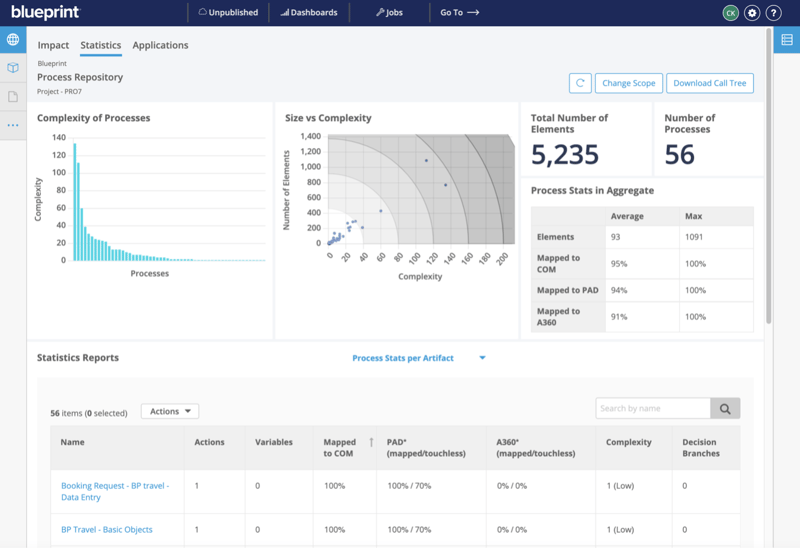
From there, you can optimize your automations and retire the ones not delivering justifiable returns, improving your entire automation estate while reducing operating costs in the process.
In the background, Blueprint’s Common Object Model (COM) – an extensive library of commands, actions, and services across all leading automation platforms – converts and maps each process into your destination RPA platform. You’ll see how much effort is required to make the migrated automation production-ready, significantly removing the labor-intensive manual effort that delays and complicates so many migration projects.
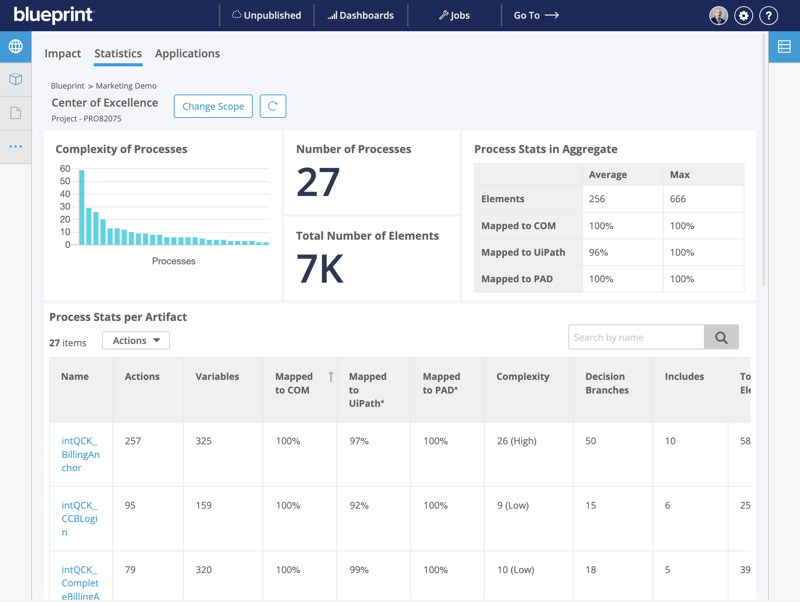
After automations have been transitioned to your destination RPA platform, Blueprint continues to deliver significant value.
With your automation estate in Blueprint, you now have a centralized, 360-degree view of your entire portfolio to optimize governance and control. A digital twin of your bot always resides in Blueprint so you can continuously optimize all your automations over time.
Blueprint’s Common Object Model (COM) is a mapping engine that ingests data from different RPA platforms and deconstructs the automation elements from these major RPA platforms into generic representations, enabling conversion into other RPA formats.
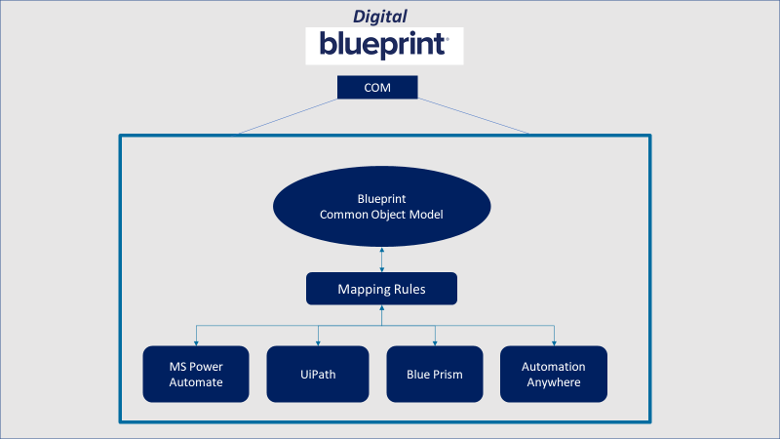
Typically, most of our customers are interested in moving to Microsoft Power Automate and Automation Anywhere's Automation 360, which we have ample experience and support for.
Blueprint delivers 60-75% time and cost savings for RPA re-platforming and migration projects when compared to manual migrations.
Blueprint also provides instant analytics and insight into your entire automation estate which can help you further reduce the total cost of ownership and optmize your automations for even greater efficiency and effectiveness.
Yes. We’ve published multiple case studies on this topic. One example features a major global telecom provider, who re-platformed over 15,000 task bots from Automation Anywhere onto Microsoft Power Automate.
70% of the process flow actions redeployed into the Microsoft Power Automate platform required no human touchpoints, saving the customer 75% in terms of time and costs when compared to the investment they would have had to make if they had attempted a manual redeployment.
For more information, you can read the full case study here.
You can find all of our RPA re-platforming and migration demos on our Product Demo Videos page.
If you're interested in seeing how Blueprint's RPA Migration solution accelerates redeployments while reducing costs between specific RPA tools, click one of the links below:
The infrastructure environments for Blueprint's cloud customers are hosted on RackSpace and Amazon Web Services (AWS).
Blueprint only operates in industry-standard data centers that are SOC II Type 2 and ISO 27001 compliant. Data center access is highly restricted and granted only to authorized personnel using multi-factor and multi-stage authentication.
Digitally replatforming RPA tools with Blueprint is significantly better than manual redeployments
Switch RPA platforms 3x Faster
Reduce Replatforming Costs by 75%
Improve the Entire Lifecycle of Your Bots
Centralize RPA Governance
Manage Change Proactively
What our Customers are Saying
Learn more about RPA replatforming with Blueprint
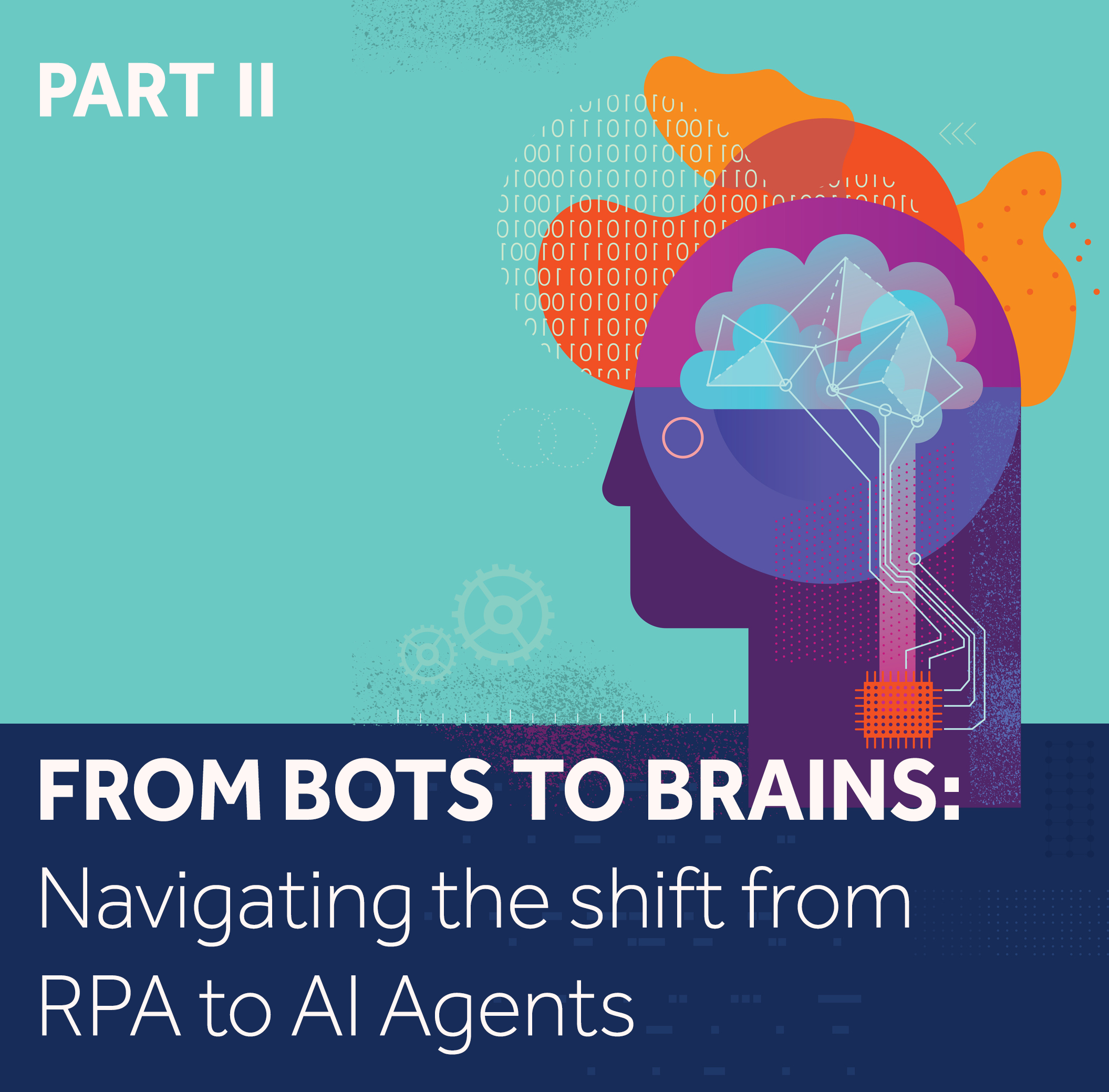
From RPA to Agent—How to Evolve Without Starting Over
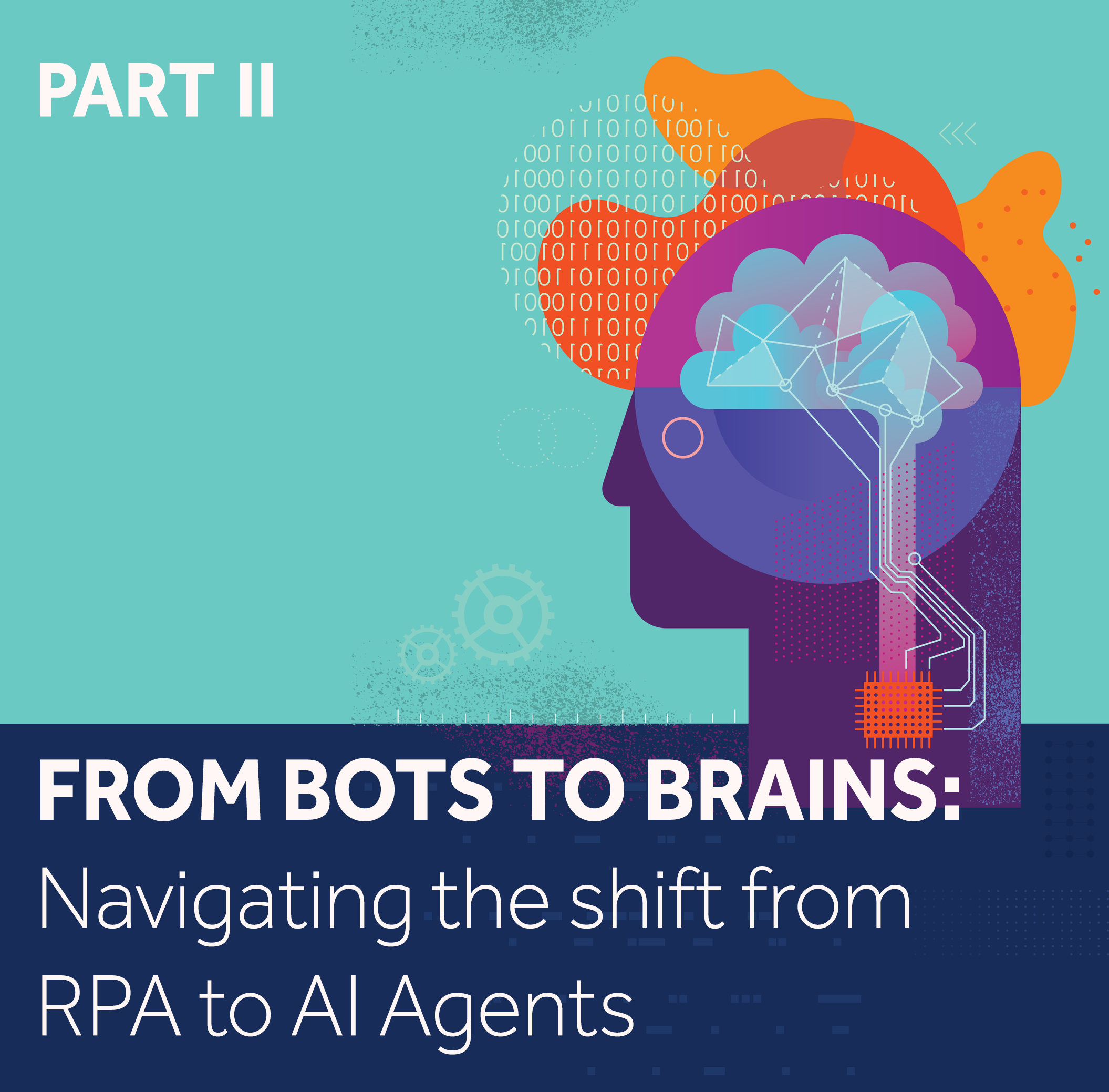
Why RPA Isn’t Going Anywhere—It’s Just Going Undercover
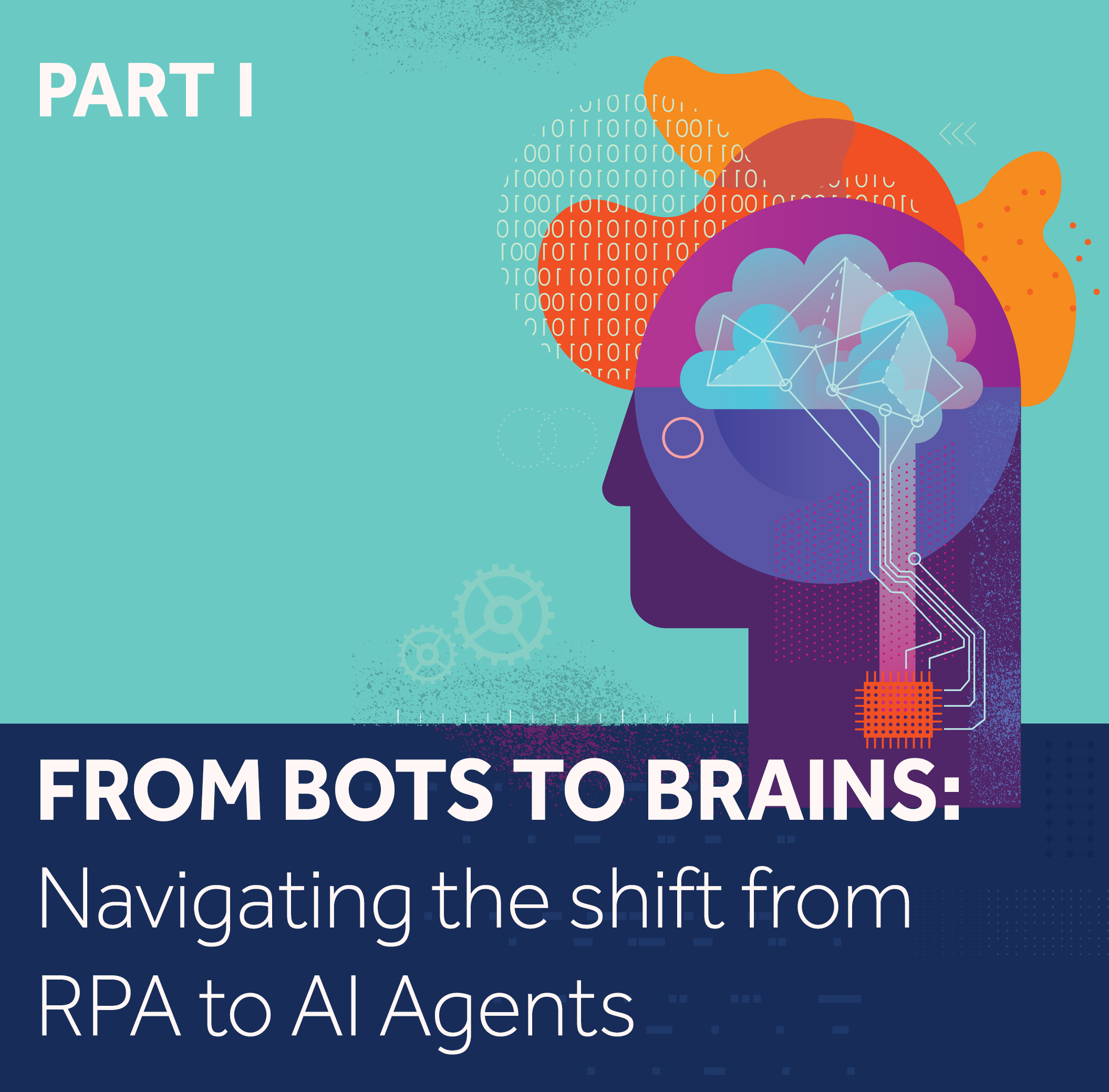
The Hype and the Reality—Are AI Agents the Future of Automation?
Start a Conversation
Speak with one of our experts to learn how Blueprint can accelerate your RPA platform migration by 3x and reduce the cost of switching by 75% to unlock greater ROI.
